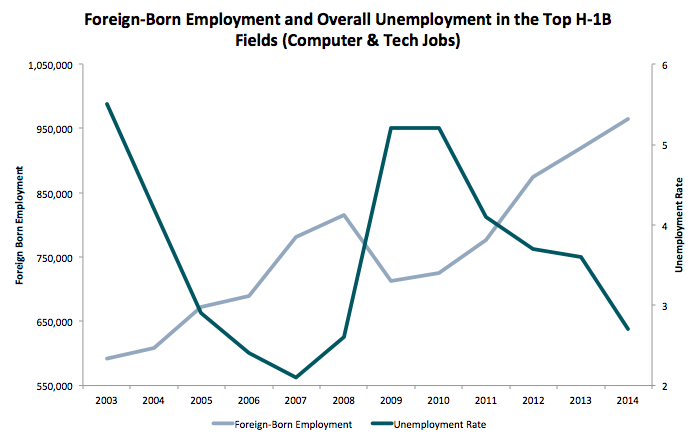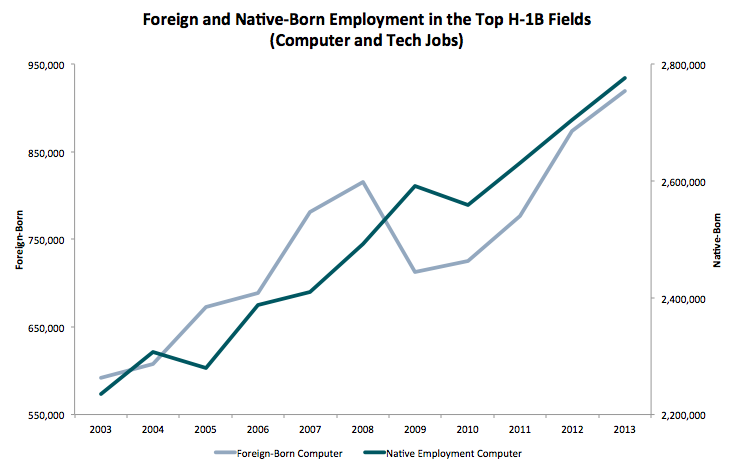A recent study I wrote about H-1B high-skilled visas was the target of a baffling blog post written by John Miano of the anti-immigration group Center for Immigration Studies (CIS). Mr. Miano appears to be confused as he essentially argues my point for me.
CIS and other opponents of H-1Bs claim that they are used to replace American workers with “cheap foreign labor.” If this were H-1Bs primary purpose, I note in my study, unemployment should rise when H-1Bs are used in greater numbers. As H-1Bs enter from abroad, they would displace natives and result in fewer employed Americans and more unemployed overall. As I show in my paper, this is false: the more H-1B requests, the lower the unemployment rate. Here’s another way to look at it:
CIS’s response to this fact is basically to concede the point. Mr. Miano quotes my paper restating his position that “if H-1Bs were primarily cheaper substitutes for American labor, the pace of H-1B requests… should rise when unemployment rises, as employers look to cut labor costs by laying off workers” and writes:
That is the exact opposite of what a thinking person would expect applying basic economics. When unemployment rises, the supply of available labor increases; under the law of supply-and-demand the cost of labor decreases, creating less of a cost advantage from using cheap foreign labor.
But Mr. Miano is arguing against his position, not mine. He should have read my very next sentence, which rejected the unemployment-H-1B request connection (“But since 2003, we see the opposite”). He strangely acts as if my summary of his views is actually my view. By rebutting the claim CIS frequently makes, Mr. Miano is agreeing with me that believing that H-1Bs are hired when companies downsize isn’t what a “thinking person” would expect. I guess we can strike CIS from the realm of “think” tanks.
Mr. Miano seems completely unaware that he is actually arguing for my point, which is, just to restate, that companies generally request H-1Bs when labor markets are tight, when they are also hiring Americans, not when they are laying them off. It’s only in his anti-H-1B world where unemployment grows with H-1B requests, not in the real world. Mr. Miano attributes the predicted consequence of his position to me and proceeds to argue against it. Thanks, I suppose.
Moreover, it’s not that the “cost advantage” of foreign labor is higher during good times, but that there are not Americans available to do the job. I noted in my study that the Bureau of Labor Statistics finds that high-skilled foreign workers earn more than college-educated American workers, and that economist Gordon Hanson has found that the same holds true in STEM fields. It’s labor scarcity that is driving employers to hire H-1Bs, not the purported cost savings.
But even if there supposedly were a cost savings, Mr. Miano assumes that H-1Bs would somehow be less advantageous during downtimes because the wages of Americans would fall, but why would they fall faster than H-1B wages? Where’s the evidence that Americans are more willing to take a pay cut than H-1Bs? CIS’s whole argument is that H-1Bs are continuously underbidding Americans. But Mr. Miano’s argument here seems to suggest that he intuitively at least realizes that this is wrong.
Moreover, if CIS doesn’t think that laying off American workers would increase unemployment, where does it think these unemployed Americas go? Do they vanish? We should see some sign of them in the employment data, but we don’t. In fact, what we do see is correlation between greater employment of foreign-born workers and greater employment of native-born workers in the top H-1B fields, confirming my point that foreign workers are hired when companies are hiring American workers.
Later in its post, Mr. Miano moves from asserting that his position is my position to just misstating my position. He writes that:
Bier provides his own charts showing correlation between H-1B numbers and employment. He attributes H-1B as the cause of employment wage growth. Interestingly, in his own charts he uses the more descriptive “H-1Bs Associated with Greater Employment” – not “causes”.
I never write the word “causes” or “cause” a single time in my paper, so this section is total fabrication. I also never discuss “employment wage growth”—whatever that is—but as for just wage growth, I state directly that rising wages in H-1B fields “do not prove that H-1Bs or foreign workers are responsible,” only that the value of these workers is growing. As for employment, I write that the “entrance of a single foreign-born worker into the top H-1B fields is associated with an increase of nearly two new jobs overall.” Associated. Not “caused.”
The upshot of all this is that despite distorting my views, CIS manages to reject much of its own theory regarding H-1B visas; that they mean higher unemployment, that H-1Bs are hired when companies are downsizing and laying off Americans. No “thinking person” would disagree.

